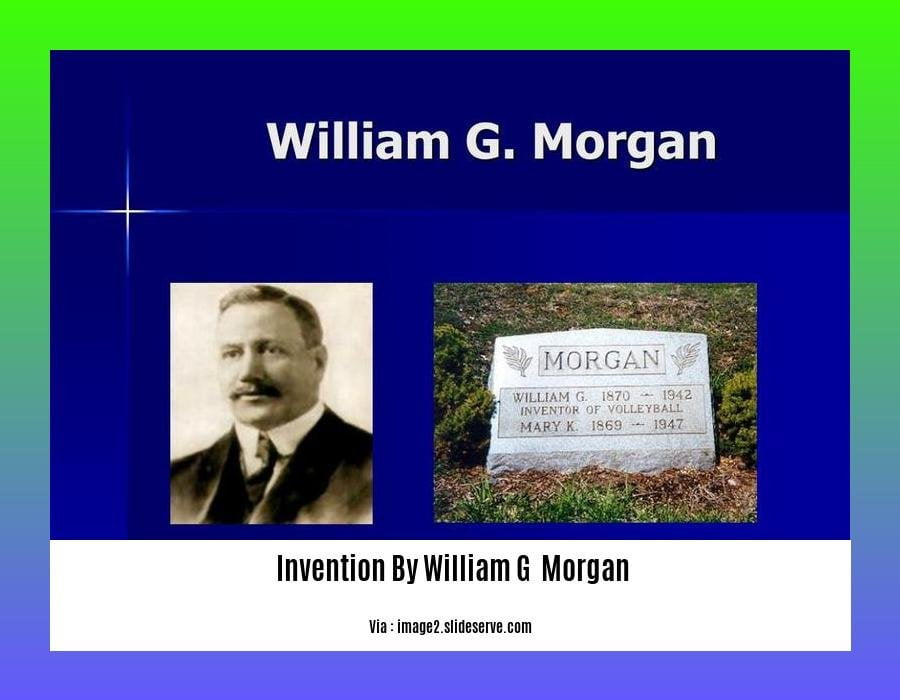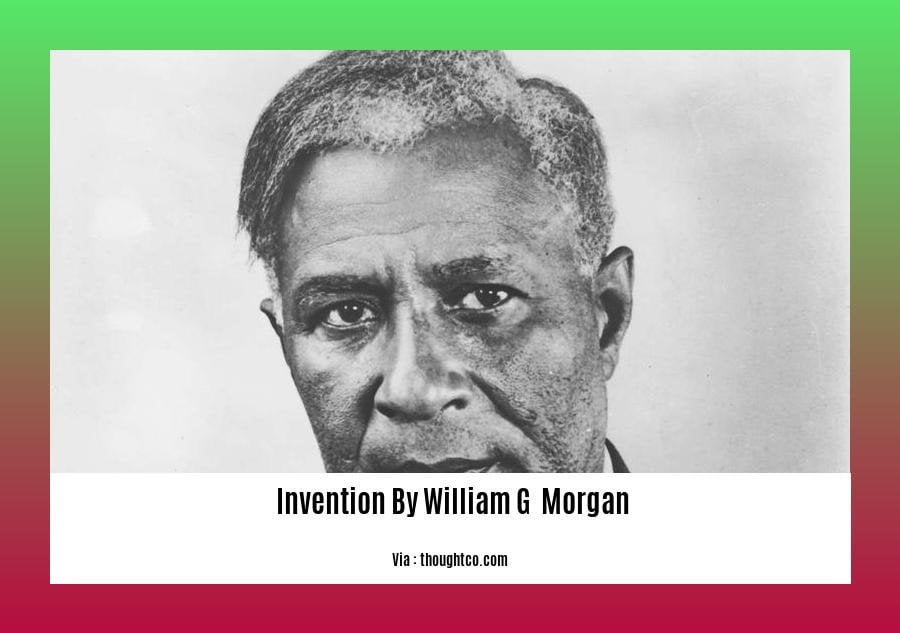Unveiling the extraordinary tale of William G. Morgan’s invention, we embark on a journey to explore the transformative impact it has had on the world of recreation. Prepare to delve into the fascinating story behind [The Invention by William G. Morgan That Revolutionized Recreation].
Key Takeaways:
- William G. Morgan invented volleyball in 1896.
- Initially called “Mintonette,” it was inspired by badminton.
- Morgan, the YMCA’s Director of Physical Education, created it as a milder alternative to basketball.
- The first volleyball game occurred at Springfield College on July 7, 1896.
- Morgan did not patent his invention.
- He passed away on December 27, 1942.
William G. Morgan’s Pioneering invention by William G. Morgan**

Volleyball’s thrilling origins trace back to the brilliant mind of William G. Morgan, a physical education director at the YMCA in Holyoke, Massachusetts. In 1896, Morgan craved a less rugged sport than basketball.
Inspired by badminton, he crafted a new game, initially named “Mintonette.” Played with a lightweight ball over a net, Mintonette swiftly captured the hearts of players at the YMCA and beyond.
The sport’s versatility shone through, played indoors or outdoors, with teams of two or more. Morgan’s invention by William G. Morgan had stumbled upon a formula for fun and fitness that would resonate globally.
A Legacy of Recreation and Sport
Volleyball’s impact on recreation and sport is immeasurable. From casual beach games to Olympic competitions, it has become a beloved pastime for millions. Its accessible nature, requiring minimal equipment and space, has contributed to its widespread appeal.
The Enduring Volleyball Spirit
Volleyball embodies teamwork, strategy, and athleticism. It fosters camaraderie, encourages physical activity, and provides a stage for spirited competition. Morgan’s invention by William G. Morgan has left an enduring legacy as a sport that promotes both enjoyment and well-being.
Volleyball’s Evolutionary Journey
Since its humble beginnings, volleyball has undergone numerous evolutions, from the initial rules to the introduction of different court surfaces and the libero position. Yet, through it all, the core principles of the game have remained constant.
- Check out the detailed account of the history of volleyball, its origins, and how it became popular here: History of Volleyball
- The journey of Olympic inclusion of volleyball as an official sport is described thoroughly: Olympic Inclusion
- You can find out more about how beach volleyball developed and gained prominence as a sport here: Beach Volleyball Development
Evolution and Popularity of Volleyball
From its humble beginnings as a YMCA game to its global status as a competitive sport, volleyball’s journey is a testament to its enduring appeal.
Volleyball’s evolution reflects the ingenuity of its inventor, William G. Morgan, who sought an indoor game that provided a gentler alternative to basketball. Inspired by badminton, Morgan introduced “Mintonette” in 1896, with a raised net and a lightweight ball.
The game’s popularity surged, attracting players of all ages and skill levels due to its versatility and accessibility. Played indoors or outdoors, with teams of varying sizes, volleyball allowed for easy adaptation to different settings.
Over time, the game’s rules evolved to enhance its athleticism and strategic depth. The introduction of spiked serves, powerful blocks, and fast-paced rallies transformed volleyball into a thrilling spectator sport. Today, volleyball boasts a worldwide following, with international competitions such as the Olympics showcasing its highest level of play.
Key Takeaways:
- William G. Morgan invented volleyball in 1896 as a less strenuous alternative to basketball.
- Initially called “Mintonette,” the game drew inspiration from badminton.
- Volleyball’s popularity soared due to its versatility, accessibility, and low equipment requirements.
- The game’s rules and techniques have evolved over time, enhancing its athleticism and strategic elements.
- Volleyball is now a global pastime, enjoyed for recreation, sport, and competition.
Sources:
Global Impact and Inclusivity

As volleyball took flight, its appeal transcended borders, becoming a global phenomenon. Its inclusivity embraced people from diverse backgrounds and abilities, fostering a sense of camaraderie and sportsmanship. The game’s simplicity made it accessible to all, promoting physical activity and social interaction.
Volleyball’s global impact is undeniable. It gained immense popularity in Asia, Europe, and South America, becoming a staple in international sporting events, including the Olympics. The sport’s versatility allowed it to be played in a wide range of settings, from beaches to indoor arenas, further contributing to its worldwide appeal.
Key Takeaways:
- Volleyball's **inclusivity** fostered camaraderie and promoted physical activity for people of all ages and abilities.
- The game's simplicity and accessibility contributed to its **global impact**, becoming a popular sport worldwide.
- Volleyball's versatility allowed it to be played in various settings, enhancing its appeal.
Sources:
- The History of Volleyball: How William G Morgan Invented The Game
- The Inventor Of Volleyball: William G Morgan A Global Phenomenon
Legacy and Continuous Growth: The Enduring Impact of William G. Morgan’s Invention
Volleyball, a sport played and enjoyed worldwide, owes its existence to the innovative mind of William G. Morgan. Invented in 1895, volleyball’s legacy and continuous growth have left an indelible mark on recreation and competitive sports.
Morgan’s Inspiration: A Game for All
Morgan, a YMCA director of physical education, sought to create a less strenuous alternative to basketball for individuals of varying athletic abilities. Volleyball emerged as a game that could be played indoors, was easy to learn, and promoted teamwork and social interaction, making it accessible to a broader population.
The Rise of a Global Pastime
Volleyball’s simplicity and inclusiveness propelled its popularity. It quickly gained traction in YMCA facilities and schools across the United States before spreading globally. Today, volleyball is played by millions worldwide, from recreational enthusiasts to elite athletes, captivating audiences in international competitions and the Olympics.
Volleyball’s Enduring Appeal
Volleyball’s appeal lies in its adaptability and versatility. It can be played indoors or outdoors, on grass, sand, or hard courts, making it accessible to people of all ages and backgrounds. The sport’s emphasis on teamwork, strategy, and athleticism fosters a sense of community and healthy competition.
Morgan’s Legacy: A Sport for Generations
Morgan’s invention of volleyball has left an enduring legacy. The sport has become a global phenomenon, providing countless hours of enjoyment, promoting physical activity, and fostering social connections. The Morgan Trophy Award, established in 1995, recognizes outstanding collegiate volleyball players, honoring Morgan’s pioneering spirit.
Key Takeaways:
- Volleyball was invented by William G. Morgan in 1895 as a less strenuous alternative to basketball.
- The sport gained popularity due to its simplicity, inclusiveness, and adaptability.
- Volleyball is now played worldwide, enjoyed by recreational enthusiasts and elite athletes alike.
- Morgan’s legacy lives on through the sport’s ongoing growth and impact on communities worldwide.
Sources:
FAQ
Q1: What was the initial name of volleyball and why was it later changed?
A1: Volleyball was initially named “Mintonette” because it borrowed elements from badminton. However, it was later renamed “volleyball” to better reflect the sport’s unique nature.
Q2: What considerations drove William G. Morgan to invent volleyball?
A2: Morgan invented volleyball as a less strenuous and more social alternative to competitive sports like basketball, catering to individuals with varying athletic abilities.
Q3: Where and when did the first volleyball game take place?
A3: The inaugural volleyball game was played on July 7, 1896, at Springfield College in Massachusetts.
Q4: What were the key differences between volleyball and other existing sports at the time of its invention?
A4: Volleyball differed from other sports in its lower impact and reduced reliance on specialized skills, making it more accessible to a wider range of participants.
Q5: How did volleyball gain widespread popularity and recognition?
A5: Volleyball’s popularity grew rapidly due to its simplicity, low equipment requirements, and suitability for both indoor and outdoor settings, appealing to diverse audiences worldwide.
- SYBAU See You Baby Meaning: Gen Z Slang Evolves - July 1, 2025
- Unlock Your Inner Youth: Lifestyle Secrets for a Vibrant Life - July 1, 2025
- Decode SYBAU Meaning: Gen Z Slang Explained - July 1, 2025






